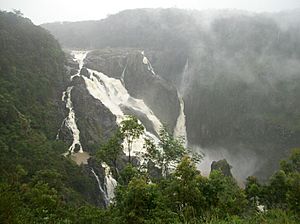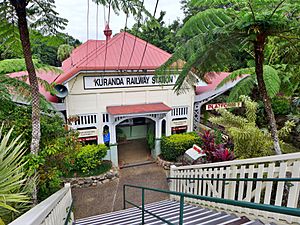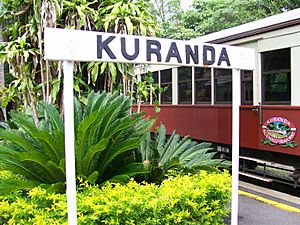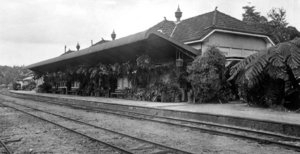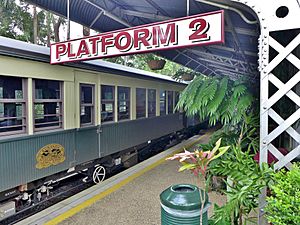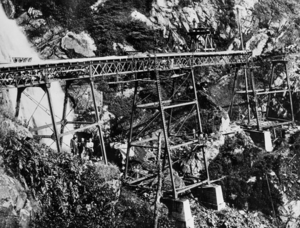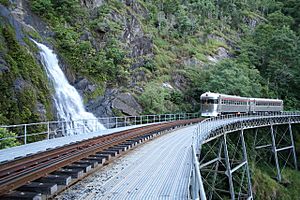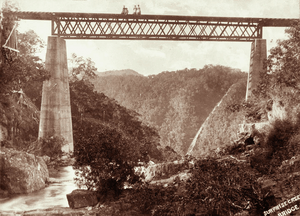Cairns-to-Kuranda railway line facts for kids
Quick facts for kids Cairns-to-Kuranda railway |
|
|---|---|
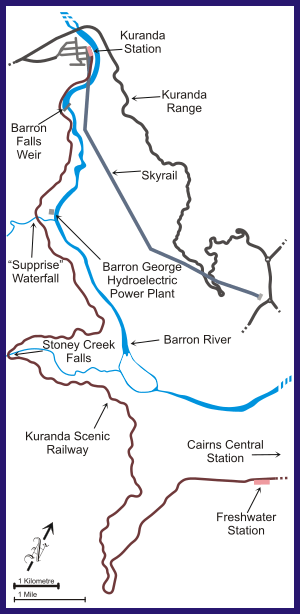
Map of the railway
|
|
| Location | Redlynch to Kuranda (4881), Redlynch, Cairns Region, Queensland, Australia |
| Design period | 1914 - 1919 (World War I) |
| Built | 1913-1915 |
| Official name: Cairns Railway, Section from Redlynch to Crooked Creek Bridge, Cairns to Kuranda Railway, Stoney Creek Bridge, Rail Bridge over Christmas Creek, Kuranda Railway Station, Surprise Creek Rail Bridge | |
| Type | state heritage (built) |
| Designated | 21 August 1992 |
| Reference no. | 600755 |
| Significant period | 1887-present |
| Significant components | signals, office/s, turntable, signal box/signal cabin/switch house/mechanical points (rail), garden - bed/s, toilet block/earth closet/water closet, shed - shelter, shed - goods, residential accommodation - station master's house/quarters, office/s, toilet block/earth closet/water closet, shed - shelter, ramp, shed - storage, drain - storm water, tank - water, shed - shelter |
| Builders | Queensland Railways |
| Lua error in Module:Location_map at line 420: attempt to index field 'wikibase' (a nil value). | |
The Cairns-to-Kuranda Railway is a famous train line in Queensland, Australia. It starts in Redlynch, a suburb of Cairns. Then it climbs up the Great Dividing Range to Kuranda on the Atherton Tableland. This amazing railway was built between 1913 and 1915 by Queensland Rail. It includes impressive structures like the Stoney Creek Bridge and the Kuranda railway station. The railway is now a special tourist attraction called the Kuranda Scenic Railway. It was added to the Queensland Heritage Register on 21 August 1992.
History of the Railway
The railway section from Redlynch to Crooked Creek Bridge is a big part of the original plan. This plan was to build a railway line all the way to Herberton. This part of the line climbs the coastal mountains. It goes around the Stoney Creek Gorge and through the beautiful Barron Gorge National Park. It reaches a height of 327.7 meters at the Barron Falls railway station. The line then continues through Kuranda railway station. This section was built between April 1887 and June 1891. It was a huge engineering challenge because the land was very steep and prone to landslides. In 2011, this section had 15 concrete tunnels and 39 timber or steel bridges.
Why the Railway Was Built
The main reason for building this railway was to help the mining industry. Gold was found near Cooktown in 1873. But it was too far from the Hodgkinson goldfield, found in 1876. So, Trinity Bay (where Cairns is) was chosen as a new port. Cairns became a port in November 1876. However, Port Douglas was founded in 1877. It offered an easier way to get to the Hodgkinson goldfield. This almost stopped Cairns from growing.
Then, tin was found in 1880. The road from Port Douglas to Herberton was still preferred. But after heavy rain in 1882, the Port Douglas road closed. People then started asking for a railway from Herberton to Cairns. The Queensland Government already wanted to connect mining towns to ports by railway.
Finding the Best Route
The government asked explorer Christie Palmerston to find a route. But in 1882, he said there was no easy natural path. The search for a rail route continued. Surveyors like George William Monk looked at different options. In 1884, Robert Ballard, a chief engineer, said Cairns was the best port. The chosen route from Cairns was through the Barron Gorge National Park. This decision made Cairns the most important town in Far North Queensland. However, the Barron Gorge was known for its unstable ground. This later caused many problems and cost a lot of money and lives.
Building the First Section
Parliament approved the first 24 miles of the railway in 1885. The first contract was given to Messrs PC Smith and Co. in 1886. But they lacked experience. McBride and Co. took over, but the government had to finish the work themselves. The first section opened on 8 October 1887. The end of this section was named Redlynch.
The Difficult Climb to Kuranda
The hardest part was building the second section, from Redlynch to Myola. This 15-mile contract was given to John Robb in January 1887. Robb was an experienced builder. He brought hundreds of workers to the job. Work began in April 1887. Robb even built a small branch line to his main construction camp at Kamerunga.
One interesting spot is Horseshoe Bend. It's a huge curve where the railway gains height. The line then climbs to the top of Barron Falls. It follows the Barron River to Kuranda. Many tunnels were planned. Sand from the Barron River was used for concrete. All the tunnels were lined with concrete.
The Cairns Railway's mountain tunnels are the largest group in Queensland. They were built between 1889 and 1891. Building these tunnels and bridges needed a lot of workers. Many Italian and Irish workers were hired. At its busiest, up to 1500 people worked on the line.
The tunnelling was done by hand. There was great danger from explosives and falling rocks. The ground was very unstable. Sadly, at least 23 workers died during construction. Many more were injured. They faced dangers from rockfalls, cave-ins, and diseases like malaria.
Workers' camps were set up along the line. These small towns had hotels, stores, and boarding houses. The project was very difficult. It cost much more than planned and took longer to finish. After a very wet season in 1891, there was major damage to the track.
When Tunnel 15 and Surprise Creek Bridge were finished in March 1891, the main work was done. The line opened for goods on 15 June and for passengers 10 days later. Despite the problems, the line was well built. This was thanks to engineers like Willoughby Hannam and John Gwynneth.
The high cost of this section delayed the railway's extension to Herberton. It finally reached Herberton in October 1910. By then, timber and farming were more important than tin.
Kuranda Railway Station
By 1891, Kuranda Station was the most important station on this section. It also became a popular tourist spot because it was close to the Barron Falls. The first station buildings were moved from Kamerunga in 1891.
In 1910, a new station building was suggested. It would be on an island platform and have trees planted. The design for the new passenger station was like a "Swiss Chalet." This was to make Kuranda a "show station." Plans were drawn in 1913-14. They included the main station building, a signal cabin, and a utilities block. These buildings were made of precast concrete units. They had a Federation style with a special terracotta tile roof.
Building the new station began in 1913 and finished in 1915. The platform was extended, and new signalling was added. The main station building was almost done by September 1914. Today, the refreshment room and kitchen are a gift shop and cafe.
Kuranda is one of the earliest stations in Australia built with precast concrete. It's the second oldest example of its kind in Queensland. The signal cabin still has its original mechanical signal frame. This system helped control train movements safely.
The station was also made beautiful with gardens. George Wreidt and Bert Wickham, two station masters, developed the tropical gardens. Kuranda Station often won the Railways' Annual Garden Competition.
By 1927, the station had a goods shed and a turntable. The turntable is used to turn trains around. Kuranda Station was important for handling freight. Trains from the west could carry more load after climbing the range.
Tourist trains also ran to Kuranda. People from Brisbane, Sydney, and Melbourne came by ship to Cairns. Then they took the train to Kuranda. Queensland Railways even published brochures to encourage tourists. They called the station "the most picturesque in Queensland."
Tourist travel stopped during World War II. But Kuranda became very busy handling freight for troops. Many soldiers were stationed on the Atherton Tablelands. After the war, tourism grew again. In the 1960s, Kuranda became a center for alternative lifestyles. The Sunday Markets, which started in the late 1970s, boosted tourism. The Skyrail Rainforest Cableway, built in the 1990s, also brought more visitors. By 2003, about 500,000 people visited the Barron Gorge National Park each year.
Redlynch Railway Station
In 2011, Redlynch Station still had a station building, a men's toilet, and a loading bank. The main part of the station building was there by 1890. It might even date back to when the first section opened in 1887. The building used to have a curved roof. The steel pipes under the current verandah were once used to hang pot plants.
The station building has been changed over the years. For example, a ladies' room was added and later changed into a goods area. As of 2018, the station building is still there but is fenced off.
Stoney Creek Railway Station
At Stoney Creek Station, a gatehouse was built in 1909. By 1911, it had a shelter shed with an office and a ladies' room. By 1936, there was also a water tank for steam trains. This tank got water from Stoney Creek Falls. There was also a sand shed. This shed was used to refill sandboxes on trains. Sand helped trains get better grip on the tracks.
Today, only the shelter shed, water tank, and sand shed remain. The gardens at the station used to have colorful tropical plants. Now, native plants are used to match the National Park. The Kuranda Scenic Railway no longer stops at this station.
Stoney Creek Bridge
Stoney Creek Bridge (Bridge 30) is in front of Stoney Creek Falls. It was designed by John Gwynneth. Its curved design is unique in Queensland. It was the only way to avoid building a tunnel. The bridge is one of only two in Queensland built with special wrought iron supports. The other is Christmas Creek Bridge.
In April 1890, the Governor of Queensland visited the bridge. A banquet was held on the almost finished bridge. The roar of the waterfall was so loud that no speeches could be made. The bridge is one of the most photographed in Australia. This is because of its beautiful location. Trains used to stop on the bridge so passengers could get out and walk around. In the late 1990s, the bridge was strengthened for safety.
Surprise Creek Bridge
Surprise Creek Bridge (Bridge 46) was built in 1890-91. It originally had timber sections. These were later replaced with steel parts from an older bridge. New steel supports were added in the late 1990s.
Christmas Creek Bridge (Bridge 48) was built in 1891. Some parts have been replaced because they rusted.
What the Railway Looks Like Today
The Cairns Railway section from Redlynch to Crooked Creek Bridge is 11.6 km from Cairns Railway Station.
Redlynch Railway Station
Redlynch railway station is at Kamerunga Road and Redlynch Intake Road. The main station building is raised on steel poles. It is made of timber and faces the railway line. Inside, the walls are simple. The building has an office and a former goods room. There are also windows and doors. The waiting shed still has its bench seats. Next to the station building is a separate men's toilet. There is also an earth loading bank.
Stoney Creek Railway Station
Stoney Creek Station is in a cutting. It has a shelter shed with an office. The shed has a dirt floor and timber walls. There are also large stone drains. At the west end of the station is a water tower and a sand shed. The water tank is made of cast iron. The sand shed is covered in corrugated iron.
Stoney Creek Bridge
After Stoney Creek Station, you find Stoney Creek Bridge (Bridge 30). It has seven sections of steel girders. These are supported by wrought iron trestles on concrete bases. This bridge is 88.4 meters long and has a curved track.
The line then goes past Glacier Rock and into the Barron Gorge. There are more bridges and tunnels. Tunnel 15 is very long, at 430 meters.
Surprise Creek Bridge
The Surprise Creek Bridge (Bridge 46) is 72.54 meters long. It is a steel bridge on tall concrete piers. It is located at the top of a waterfall. Then comes Christmas Creek Bridge (Bridge 48). This is the sixth steel lattice girder bridge on this section. It is 39.6 meters long.
The line continues past Robb's Monument. Then it reaches Barron Falls Station. This station has a modern platform and a lookout over the Barron Falls. The line then goes along the Barron River to Jumrum Creek Bridge.
Kuranda Railway Station
Kuranda Station (at 33.23 km) is the northernmost operating station in Queensland. It is built on a raised island platform. The station has several separate buildings. The main one is the passenger station building.
The station building is a single-story rectangular building. It has a special roof with awnings over the platforms. The roof has three metal vents. The building has a booking lobby, a station master's office, a waiting shed, and ladies' toilets. The eastern end has a gift shop and cafe.
The buildings are made of precast concrete planks. They have timber roofs. The windows and doors are timber-framed. Inside, the walls are painted concrete. The station is decorated with potted palms and hanging baskets.
Other buildings on the platform include a signal cabin and a utilities block. The signal cabin is a small building with a timber roof. It has a mechanical signal frame inside. This system helps control the signals and points around the station. The utilities block has men's toilets and storage rooms.
North-west of the station building is a pedestrian bridge and a luggage lift. These are modern replacements. There is also a stone monument to the railway's builders. The former station master's house is nearby. A railway turntable is also located further north-west.
At the south-east end of the platform is another garden. There is also a goods shed. Four semaphore signal towers are located around the station. These towers have kerosene lamps with colored lenses.
Crooked Creek Bridge
After leaving Kuranda Station, the line reaches the Crooked Creek Bridge (at 34.75 km). This bridge has steel girders. They are supported by a concrete pier and later steel piers.
Some modern things you might see along the line are new buildings, fences, and rock fall barriers. These are not part of the original heritage.
Why This Railway is Special
The Cairns Railway from Redlynch to Crooked Creek Bridge is very important to Queensland's history.
- Showing History: It shows how railways were built to connect mining towns to ports. This helped Queensland's economy grow. Cairns became a big town because of this railway. The railway also helped timber and farming on the Atherton Tableland. Redlynch Station is important as the start of the climb to Kuranda.
- Rare Features: Kuranda Railway Station has rare pre-cast concrete buildings. It also has one of the few working mechanical signal cabins in Queensland. Stoney Creek Station has a rare water tank and sand shed. These show how steam trains used to work. The Stoney Creek Bridge has a unique curved design. It is one of only two Queensland railway bridges built with special wrought iron supports.
- Hidden Information: The old camp sites along the railway might hold clues. They could tell us about the lives of the railway workers in the 1880s.
- Great Engineering: This railway is a great example of how to build a line over mountains. It has 15 tunnels, 15 steel bridges, and 24 timber bridges. The tight curves, cuttings, and drains show the amazing engineering needed for such difficult land.
- Beautiful Scenery: The train trip through the Barron Falls National Park is very popular. People love the rugged beauty, the many bridges and tunnels, and the views. Stoney Creek Bridge is one of Australia's most photographed railway bridges. Kuranda Railway Station is known for its beautiful setting and gardens.
- Amazing Achievement: Climbing to 327.7 meters at Barron Falls Station was a huge engineering feat. It shows the skill of the builders and engineers. They had to deal with unstable and rough land.
- Community Connection: The train trip from Cairns to Kuranda is very important to many people. Thousands of visitors enjoy this scenic railway every year. Stoney Creek Bridge and Kuranda Railway Station are famous tourist spots around the world.



